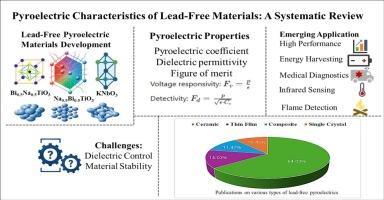Pyroelectric characteristics of lead-free materials: A systematic review
IF 3.4
3区 物理与天体物理
Q2 INSTRUMENTS & INSTRUMENTATION
引用次数: 0
Abstract
Pyroelectric materials, that generate electrical polarization in response to temperature fluctuations, are widely used in infrared detection, energy harvesting, and biomedical applications. However, environmental and health concerns associated with traditional lead-based materials, such as PZT and PMN-PT, have opened the new window of exploring sustainable lead-free alternatives. This systematic review comprehensively examines recent advancements in lead-free pyroelectric ceramics, focusing on their structural design, performance optimization, and key challenges. Promising materials, including bismuth sodium titanate (BNT), potassium sodium niobate (KNN), and sodium bismuth titanate (NBT)-based ceramics, exhibit competitive pyroelectric coefficients (up to 2720 µC/m2K) and thermal stability. Key strategies to enhance performance are; doping, phase boundary engineering, and porosity control, which significantly improve pyroelectric figures of merit (FOMs). For instance, La-doped BNT-BNN ceramics achieve a high pyroelectric coefficient (14.3 × 10−4C/m2K) with a depolarization temperature of 174 °C, while porous BaTiO3-SnO2 composites demonstrate a 47 % reduction in dielectric constant, enhancing detectivity. Despite these advancements, challenges such as high dielectric loss, thermal instability, and poling inefficiency also persist with these materials. These issues can be addressed through compositional tuning and microstructure optimization, that can enable lead-free materials to surpass conventional lead-based systems. This review provides a roadmap for lead-free pyroelectric technologies, emphasizing the balance between material properties as well as practical feasibility, further focussing on scalable synthesis, thermal endurance, and integration into functional devices to realize their full commercial potential.

无铅材料的热释电特性:系统综述
热释电材料,产生电极化响应温度波动,广泛应用于红外探测,能量收集和生物医学应用。然而,与传统铅基材料(如PZT和PMN-PT)相关的环境和健康问题打开了探索可持续无铅替代品的新窗口。本文系统回顾了无铅热释电陶瓷的最新进展,重点介绍了无铅热释电陶瓷的结构设计、性能优化和主要挑战。包括钛酸铋钠(BNT),铌酸钾钠(KNN)和钛酸铋钠(NBT)基陶瓷在内的有前途的材料,具有竞争性的热释电系数(高达2720µC/m2K)和热稳定性。提高绩效的主要策略有:掺杂、相边界工程和孔隙率控制,这些都显著提高了热释电性能(FOMs)。例如,掺la的BNT-BNN陶瓷具有较高的热释电系数(14.3 × 10−4C/m2K),退极化温度为174℃,而多孔BaTiO3-SnO2复合材料的介电常数降低了47%,增强了探测性。尽管取得了这些进步,但这些材料仍然面临着诸如高介电损耗、热不稳定性和极化效率低下等挑战。这些问题可以通过成分调整和微观结构优化来解决,这可以使无铅材料超越传统的铅基系统。这篇综述为无铅热释电技术提供了一个路线图,强调在材料性能和实际可行性之间的平衡,进一步关注可扩展合成,耐热性和集成到功能器件中,以实现其全部商业潜力。
本文章由计算机程序翻译,如有差异,请以英文原文为准。
求助全文
约1分钟内获得全文
求助全文
来源期刊
CiteScore
5.70
自引率
12.10%
发文量
400
审稿时长
67 days
期刊介绍:
The Journal covers the entire field of infrared physics and technology: theory, experiment, application, devices and instrumentation. Infrared'' is defined as covering the near, mid and far infrared (terahertz) regions from 0.75um (750nm) to 1mm (300GHz.) Submissions in the 300GHz to 100GHz region may be accepted at the editors discretion if their content is relevant to shorter wavelengths. Submissions must be primarily concerned with and directly relevant to this spectral region.
Its core topics can be summarized as the generation, propagation and detection, of infrared radiation; the associated optics, materials and devices; and its use in all fields of science, industry, engineering and medicine.
Infrared techniques occur in many different fields, notably spectroscopy and interferometry; material characterization and processing; atmospheric physics, astronomy and space research. Scientific aspects include lasers, quantum optics, quantum electronics, image processing and semiconductor physics. Some important applications are medical diagnostics and treatment, industrial inspection and environmental monitoring.

 求助内容:
求助内容: 应助结果提醒方式:
应助结果提醒方式:


